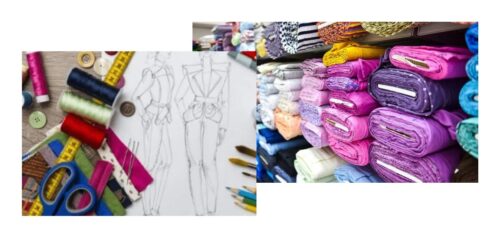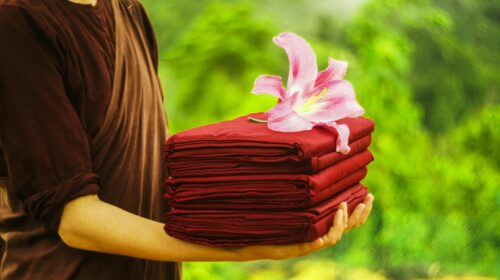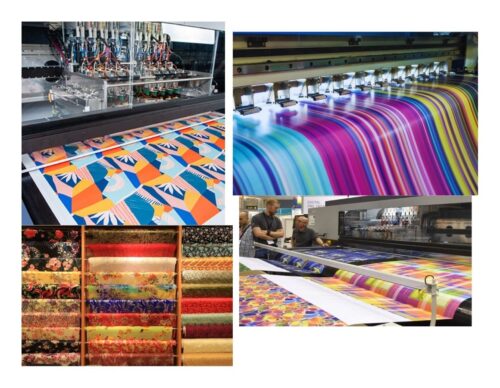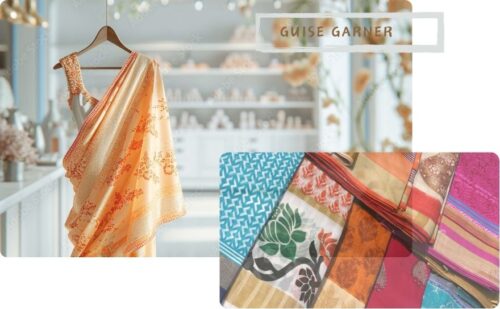Fashion Textile: Unleashing Creativity and Style
“Fashion textiles are the brushstrokes that paint our style, weaving together creativity, expression, and elegance into wearable works of art.”

It is a dynamic and ever-evolving industry that plays a pivotal role in shaping our personal style and self-expression. It encompasses a wide range of fabrics, patterns, colors, and designs that are used in the creation of garments and accessories. From luxurious silk dresses to comfortable cotton t-shirts, fashion textiles form the foundation of the fashion world, allowing designers to unleash their creativity and make bold statements through their creations. In this article, we will delve into the fascinating world of fashion textile, exploring its importance, trends, and impact on the fashion industry.
The Evolution of Fashion Textile
Fashion textile has a rich history that dates back centuries. Initially, clothing was primarily made from natural materials such as animal hides, plant fibers, and woven fabrics. As civilizations advanced, textile production techniques evolved, giving rise to more intricate weaves, dyes, and embellishments. The industrial revolution in the 18th century marked a significant turning point in the textile industry, with the advent of mechanized production processes.
Importance of Fashion Textile in the Fashion Industry
Fashion textile forms the very foundation of the fashion industry. It provides designers with a diverse range of materials to experiment with, enabling them to bring their creative visions to life. The choice of textile can completely transform the look and feel of a garment, making it essential in creating unique and captivating designs. Additionally, fashion textile serves as a means of self-expression for individuals, allowing them to showcase their personality and style through the clothes they wear.
Different Types of Fashion Textiles
Natural Fibers
Natural fibers are derived from various sources such as plants (cotton, linen), animals (wool, silk), and minerals (asbestos). These fibers offer breathability, comfort, and durability, making them popular choices for clothing. Natural fibers also have the advantage of being biodegradable and environmentally friendly.
Synthetic Fibers
Synthetic fibers, also known as human-made or artificial fibers, are created through chemical processes. Examples include polyester, nylon, and acrylic. Synthetic fibers often mimic the properties of natural fibers while offering additional benefits such as wrinkle resistance, stretchability, and colorfastness. They are widely used in sportswear, swimwear, and outdoor gear.
Blended Fabrics
Blended fabrics are a combination of natural and synthetic fibers. By blending fibers, designers can achieve the desired characteristics of both types, resulting in fabrics that are comfortable, durable, and easy to care for. Common blends include cotton-polyester and wool-silk.
Here is a list of various fashion textiles:
- Cotton
- Silk
- Wool
- Linen
- Polyester
- Rayon
- Nylon
- Acrylic
- Spandex
- Velvet
- Satin
- Denim
- Chiffon
- Organza
- Tulle
- Chambray
- Flannel
- Tweed
- Jacquard
- Lace
These are just a few examples of fashion textiles. There are many more variations and blends available in the market, each with its unique characteristics and uses.
Manufacturing and Production Process
The manufacturing and production of fashion textiles involve several stages. It begins with the sourcing of raw materials, followed by processes such as spinning, weaving, knitting, dyeing, and finishing. Technological advancements have revolutionized the production process, making it more efficient and sustainable.
Sustainability in Fashion Textile
In recent years, there has been a growing emphasis on sustainability in the fashion industry, including fashion textile production. Sustainable practices aim to minimize the negative impact on the environment and promote ethical working conditions. Eco-friendly textiles, recycled fibers, and reduced water and energy consumption are some of the ways the industry is striving towards a more sustainable future.
Influential Fashion Textile Designers
Fashion textile designers play a crucial role in shaping trends and pushing boundaries. Their innovative use of fabrics and patterns influences the direction of the fashion industry. Designers like Alexander McQueen, Mary Katrantzou, and Iris van Herpen have made significant contributions to the field of fashion textile, redefining the possibilities of textile design.
Fashion Textile Trends
Fashion textile trends are ever-changing, reflecting the zeitgeist of each era. Here are some current trends that are making waves in the fashion industry:
Bold Prints and Patterns
Vibrant and eye-catching prints and patterns are gaining popularity. From abstract geometrics to floral motifs, bold designs add an element of excitement and individuality to garments.
Sustainable and Eco-Friendly Textiles
With sustainability becoming a pressing concern, there is a rising demand for fashion textiles made from organic and recycled materials. Designers are incorporating eco-friendly fabrics like bamboo, hemp, and organic cotton into their collections.
Metallic and Shimmery Fabrics
Metallic and shimmery textiles are making a comeback, adding a touch of glamour to outfits. Gold, silver, and copper hues create a striking visual impact, perfect for evening wear and special occasions.
Textured Fabrics
Textured fabrics such as velvet, jacquard, and brocade are being used to add depth and tactile interest to garments. Textures create a sense of luxury and can elevate a simple design.
The most popular fabrics for fashion
Cotton, silk, polyester, wool, linen, rayon, nylon, and denim are among the most popular fabrics in fashion. Cotton is versatile and breathable, while silk adds luxury. Polyester offers durability, wool provides warmth, and linen is lightweight. Rayon offers a soft feel, nylon brings strength, and denim is known for its durability. These fabrics cater to different fashion needs, from everyday wear to formal attire and activewear.
The Role of Fashion Textile in Cultural Expression
Fashion textile serves as a powerful medium for cultural expression. Traditional textiles and techniques are often incorporated into contemporary designs, celebrating diversity and heritage. Clothing becomes a canvas for cultural storytelling and a means of preserving traditional craftsmanship.
How Fashion Textile Influences Consumer Behavior
Fashion textile plays a significant role in shaping consumer behavior. The choice of fabric, color, and design influences the perceived value and desirability of a garment. Consumers are drawn to textiles that evoke emotions, cater to their lifestyle, and align with their personal values.
Future of Fashion Textile: Technological Advancements
The future of fashion textile holds exciting possibilities with technological advancements. Innovations such as smart textiles, 3D printing, and sustainable fabric development are transforming the industry. These advancements offer new avenues for creativity and functionality, paving the way for a more sustainable and technologically integrated future.
How to style Fashion Textile
It encompasses a wide range of materials, patterns, and designs that are used to create stunning garments and accessories. Whether you’re a fashion enthusiast or a professional designer, understanding how to style fashion textiles is crucial. In this article, we will explore various tips and techniques to help you elevate your fashion game and create unique and stylish outfits. So, let’s dive in! Read more..
How to shop
When it comes to shopping for fashion textiles, there are a few steps you can follow to make the process easier and more enjoyable. Here’s a guide to help you:
Determine your needs: Start by deciding what type of fashion textiles you are looking for. Consider factors such as the purpose (clothing, accessories, home decor), fabric type (cotton, silk, polyester), and design preferences (patterns, colors).
Research fashion trends: Stay up-to-date with the latest fashion trends to get inspiration for your textile choices. Browse fashion magazines, websites, and social media platforms to gather ideas and understand what styles are currently popular.
Set a budget: Determine how much you are willing to spend on fashion textiles. This will help you narrow down your options and prevent overspending. Consider the quality and durability of the fabric when setting your budget.
Choose the right store: Look for stores that specialize in fashion textiles or fabric shops that offer a wide variety of options. Research online to find local stores or explore online platforms that sell textiles. Read reviews and check the reputation of the store to ensure a positive shopping experience.
Visit the store: If you have selected a physical store, visit it in person to see and feel the textiles. Examine the quality, texture, and color of the fabrics you are interested in. Ask the staff for assistance or recommendations if needed.
More You Can do is-
Online shopping: If you prefer online shopping, explore websites that sell fashion textiles. Pay attention to product descriptions, including fabric composition, dimensions, and care instructions. Look for high-resolution images that show the fabric’s details and colors accurately.
Compare prices and options: Compare prices and quality across different stores or websites to ensure you’re getting the best value for your money. Consider factors like shipping costs, return policies, and customer reviews when making comparisons.
Purchase and check out: Once you have made your selection, add the chosen textiles to your cart and proceed to checkout. Provide the necessary information for shipping and payment, ensuring that the website is secure and your personal data is protected.
Care for your textiles: After you receive your fashion textiles, follow the care instructions provided. Properly washing, ironing, and storing the fabrics will help maintain their quality and longevity.
Get creative: Finally, unleash your creativity and start using the fashion textiles in your desired projects. Whether it’s sewing clothes, making accessories, or creating home decor items, let your imagination run wild!
Remember, shopping for fashion textiles should be a fun and inspiring experience. Enjoy the process of exploring different options and discovering fabrics that reflect your personal style.
Where to shop
There are several places where you can buy fashion textiles:
Fabric Stores: Visit local fabric stores in your area. These stores offer a wide variety of fabrics suitable for different fashion projects. You can explore different textures, colors, and patterns to find the perfect fabric for your needs.
Online Marketplaces: Online platforms like Amazon, eBay, Etsy, and Fabric.com provide an extensive range of fashion textiles. You can browse through their collections, compare prices, read customer reviews, and conveniently order fabrics from the comfort of your home.
Fashion Districts: Many cities have designated fashion districts or wholesale fabric markets. These areas host numerous fabric shops and suppliers, offering a diverse selection of fashion textiles. Exploring these districts can be a great way to discover unique fabrics and find inspiration.
Trade Shows and Exhibitions: Attend trade shows and fashion exhibitions, where textile manufacturers and suppliers showcase their latest collections. These events provide an opportunity to see and feel the fabrics firsthand, connect with industry professionals, and make direct purchases.
Online Fabric Retailers: Various online retailers specialize in selling fashion textiles. Websites like Mood Fabrics, Fabric Mart, and Fashion Fabrics Club offer a wide range of fabrics, often with detailed descriptions, swatch options, and reliable shipping services.
Remember to consider factors such as fabric quality, composition, and suitability for your specific project when making a purchase. It’s also a good idea to check customer reviews and ratings to ensure a positive buying experience.
If you’re looking to buy fashion textiles in India, here are some popular options:
- FabIndia
- Nalli
- Saroj Fabrics
- Jaipur Fabric
- The Chennai Silks
- Kalanjali
Remember to visit their respective websites or contact them directly to explore their collections, check availability, and make purchases.
If you’re looking for international options to buy fashion textiles, here are some well-known retailers that offer a wide range of fabrics and ship internationally:
- Mood Fabrics
- Fabric.com
- Etsy
- Fashion Fabrics Club
- Alibaba
- eBay
Before making a purchase, ensure to review the shipping policies, delivery times, and any additional charges associated with international shipping. Additionally, check the customer reviews and ratings to ensure a positive buying experience.
Conclusion
Fashion textile is a dynamic and influential aspect of the fashion industry. From its historical roots to the latest trends and technological advancements, fashion textile continues to captivate designers, consumers, and enthusiasts alike. With its ability to evoke emotions, reflect cultural diversity, and push boundaries, fashion textile will remain an essential element in the world of fashion.
FAQs
Q. Are fashion textiles only used in clothing?
A. No, fashion textiles are used not only in clothing but also in accessories such as bags, shoes, and hats.
Q. How can I determine the quality of a fashion textile?
A. The quality of a fashion textile can be determined by factors such as durability, colorfastness, and the feel of the fabric.
Q. Can sustainable fashion textiles be stylish?
A. Yes, sustainable fashion textiles can be stylish. Designers are increasingly creating eco-friendly fabrics that are both environmentally conscious and fashionable.
Q. Are natural fibers more sustainable than synthetic fibers?
A. Natural fibers are generally considered more sustainable as they are biodegradable and renewable. However, advancements in technology have made it possible to create sustainable synthetic fibers as well.
Q. How can I incorporate fashion textile trends into my personal style?
A. You can incorporate fashion textile trends into your personal style by selecting garments and accessories that feature the latest prints, textures, or sustainable fabrics that align with your preferences. Read more…





